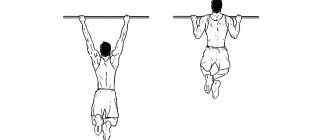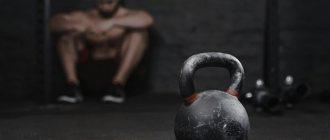© Prostock-studio — stock.adobe.com
Share:
What you need
- horizontal bar
Can't go to the gym regularly? Don't fall into despair! You can fully train without going far from home with the help of the simplest sports equipment - a horizontal bar. A well-designed horizontal bar training program for beginners allows you to work out almost all the muscles of the torso: latissimus dorsi, biceps, triceps, deltoids and abs.
The benefits of exercising on the horizontal bar
There are dozens of varieties of exercises on the horizontal bar: pull-ups in various variations, push-ups, hanging leg raises, power-ups and many others. Finding the ones that suit your purposes won’t be difficult. With the help of the complexes described in the article, you will gain muscle mass, become stronger and improve your relief. However, methodicality and consistency are important in everything, and training on the horizontal bar with your own weight is no exception.
In this article we will analyze several of the best training programs on the horizontal bar, answer the question of how to create an individual program, and give useful tips and recommendations.
Benefits of training
It is no coincidence that exercises on the horizontal bar and parallel bars form the basis of general physical training (GPP). Men are taught to practice on the horizontal bar from childhood: both at school and in any sports section. In the army and in physical education at the university, these exercises are also not ignored. How are they useful and what are their main advantages?
- Availability and prevalence. There are horizontal bars in every yard: you don’t have to waste time getting to the training place. In large cities there are more and more well-equipped workout areas with horizontal bars of different heights and widths, parallel bars, rings, ladders for grip training, ropes and other equipment. All this is free. You can do it even simpler - buy or make a horizontal bar yourself and play sports without leaving your home.
- Variety of the training process. If you think that training on the horizontal bar is limited to just pull-ups, you are deeply mistaken. Having a certain physical training, you can work out almost all the muscles of the torso on the horizontal bar.
- Safety. If you follow the correct exercise technique, the risk of injury is minimized. The rules are simple: during pull-ups and other pulling exercises, do not tilt your head back too much, do not round the thoracic spine, and do not make circular movements with your shoulders.
- Increased muscle mass and strength. On the horizontal bar it is easy to implement the principle of progression of loads, which will make you bigger and stronger. Also, training with your own weight strengthens ligaments and tendons, which increases strength potential.
- Save time. Training on the horizontal bar will not take much time. 25-30 minutes is enough to complete the entire planned amount of work.
Positive effect on the body
It has been proven that prolonged hanging on the horizontal bar without the use of wrist straps relieves hypertonicity in the spinal extensors, strengthens the grip, improves posture and reduces the risk of back injuries.
Continuous work with your own weight allows the muscles to overcome pain and a burning sensation in the muscles. Refusal comes much later. Over time, athletes adapt to such loads, and training on the horizontal bar is much easier.
Among other things, playing sports in the fresh air is much healthier for the body than in a stuffy gym. A higher oxygen content in the air promotes rapid recovery between approaches and improves the oxidation process of adipose tissue.
Contraindications
Not all athletes will benefit from training on the horizontal bar. It is widely believed that hanging on the horizontal bar has almost miraculous properties and helps with hernias and protrusions. Unfortunately, this is far from the case.
If you have such problems with the spine, you should not train on the horizontal bar at all, since a long time in an extended position can aggravate the situation.
Be sure to consult with a qualified physician before beginning full-scale exercise. Only he will competently answer the question of how to play sports and not harm your health.
It is also not recommended to exercise on horizontal bars for those who have recently had sprains or torn ligaments in their shoulders or elbows. Hanging for a long time will lead to pain, especially if your own weight is above average. You risk recurrence of the injury.
Program for Beginners
The first thing beginners need to do is learn how to do pull-ups technically correctly. Pull-ups are performed not by the biceps and forearms, but by the latissimus dorsi muscles. This is the basis on which all other exercises are built. The easiest way to do this is to try to bring your shoulder blades together as you lift your body up. No need to swing.
The pulling movement itself should be performed not due to some kind of impulse, but due to compression of the latissimus dorsi muscles. It is quite difficult to feel this movement, and often it takes more than one month of training. But when you learn to do this, your back will begin to grow at an enviable speed. Another option is to use straps, they help to “turn off” your arms.
Before you start performing the complexes, you need to do a test - do pull-ups with a wide grip for the maximum number of times. If you manage to do more than 5, skip the first program and immediately proceed to the second. If you manage to do 1-4 times, start with a simple 4-week program to increase the number of pull-ups:
| Week 1 | |
| Number of approaches | Number of repetitions |
| Day 1 | |
| 5 | 1, 1, 1, 1, maximum |
| Day 2 | |
| 5 | 1, 1, 1, 1, maximum |
| Day 3 | |
| 5 | 1, 2, 1, 1, maximum |
| Week 2 | |
| Number of approaches | Number of repetitions |
| Day 1 | |
| 5 | 1, 2, 1, 1, maximum |
| Day 2 | |
| 5 | 2, 2, 2, 1, maximum |
| Day 3 | |
| 5 | 2, 2, 2, 2, maximum |
| Week 3 | |
| Number of approaches | Number of repetitions |
| Day 1 | |
| 5 | 2, 3, 2, 2, maximum |
| Day 2 | |
| 5 | 3, 4, 3, 3, maximum |
| Day 3 | |
| 5 | 3, 4, 3, 3, maximum |
| Week 4 | |
| Number of approaches | Number of repetitions |
| Day 1 | |
| 5 | 3, 4, 3, 3, maximum |
| Day 2 | |
| 5 | 4, 5, 4, 4, maximum |
| Day 3 | |
| 5 | 4, 5, 5, 5, maximum |
The horizontal bar training program for those who were able to perform more than 5 pull-ups is designed for 3 sessions per week. Other exercises have already been added here. Each workout is quite short, no more than 30 minutes.
| Monday | ||
| "Jumping" pull-ups | 3x10-15 | |
| Horizontal pull-ups on a low bar | 3x10-12 | |
| Wide grip pull-ups | 3x5-7 | |
| Hanging on the horizontal bar | 4xmaximum | |
| Wednesday | ||
| Hanging leg raises to the bar | 3x8-10 |
|
| "Janitors" | 3x6-8 | |
| Imitation of French press on a low bar | 4x10-15 | |
| Hanging on the horizontal bar | 4xmaximum | |
| Friday | ||
| "Jumping" pull-ups | 3x10-15 | |
| Head pull-ups | 3x5-7 | |
| Close-grip pull-ups | 3x4-6 | |
| Hanging on the horizontal bar | 4xmaximum | |
Once you can complete the entire amount of work without much effort, begin to slowly increase the number of repetitions and approaches. Also, from time to time, measure your progress separately in pull-ups, because this is the basis of all exercises on the horizontal bar. If you can easily and technically perform 15 reps, it's time to move on to heavier training for more experienced athletes.
Another great option for increasing the load is to use additional weights. A backpack filled with something heavy, such as sandbags or water bottles, works well here.
Pull-up technique
Many people can do pull-ups a small number of times, but to influence a specific muscle group, you need to perform the exercise correctly. As practice shows, even experienced and developed athletes do not always manage to do more than five pull-ups correctly. Before performing a pull-up program at home, a good warm-up and warm-up of the muscles is necessary. It is best to do push-ups from the floor several times and stretch your shoulder joints. When performing exercises on the crossbar at home, you must follow a certain technique.
- Maintaining correct body position . You need to fix your legs, you can fix them together and bend your knees at an angle of ninety degrees. In this position, lifting is carried out due to the strength of the arm muscles (the help of the legs and pelvis is excluded), and the work of the back is felt.
- Frequency and effort. To thoroughly work out the muscles, the exercise is best performed slowly, that is, lifting and lowering the body should be done at the same speed and evenly. There should be no jerking when moving. Hands must be kept tense. Muscle mass should be felt.
- Correct breathing: when ascending, inhale evenly, when lowering, exhale.
Program on the horizontal bar for gaining weight
If you are a fairly experienced athlete and have a good command of the technique of all basic exercises, then this weight training program on the horizontal bar is for you. By doing it, you will add muscle mass in your arms, back and shoulders.
The bar training program for gaining mass is built around multi-joint movements that involve several large muscle groups at once. The work is carried out in the repetition range from 8 to 15. Only three workouts per week, but rest between approaches should be minimal - this way you will increase blood flow to the working muscles, without which muscle growth is impossible.
| Monday | ||
| Wide grip pull-ups | 3x12 | |
| Two-handed force exit | 3x6-8 | |
| Parallel grip pull-ups | 3x8-10 | |
| Horizontal pull-ups on a low bar | 4x15 | |
| Wednesday | ||
| Head pull-ups | 4x10 | |
| Pull-ups | 4x12-15 | |
| Diagonal pull-ups | 3x8 | |
| One arm hang | 3xmaximum | |
| Friday | ||
| Close-grip pull-ups | 4x10-12 | |
| Imitation of French press on a low bar | 4x12-15 | |
| Straight leg raises to the bar | 3x12 | © Makatserchyk — stock.adobe.com |
| Hanging Knee Raises | 3x15 |
|
As you can see, in every workout we directly or indirectly load all the major muscles of the core. This approach to training does not lead to overtraining at all, since the amount of work is not as large as with a classic three-day split in the gym. The muscles have time to fully recover.
To maintain the intensity of the training process, try to rest as little as possible between working approaches - no more than one minute. If the specified amount of work is too small for you, add 1-2 sets to each exercise and increase the number of repetitions to 15. You can also use additional weights.
As an introduction
Correct work on the horizontal bar at home or in the gym is an opportunity to perfectly develop all muscle groups of the upper body, including the abdominals and back. The only thing you need is a high-quality program at hand and strict adherence to it.
The ideal number of weekly sessions is four, training time is 20-30 minutes. For example, you can organize classes on all days except weekends. But here you can plan your schedule yourself, taking into account your work and rest schedule. Below we will look at how to pump up on the horizontal bar the fastest.
Relief program
In terms of the strength component, the training program on the horizontal bar for relief is not too different from working on weight. In both cases we train in the medium rep range (8 to 15) and do similar exercises. This is the optimal amount not only for gaining weight, but also for maintaining it.
The main difference between the dialing and cutting modes is nutrition. It is this that determines whether an athlete will build muscle mass or burn excess fat. Also, while drying, you can add cardio in separate workouts: jogging, cycling, etc.
To increase calorie consumption during strength training, we will need some exercises from CrossFit:
| Monday | ||
| Burpee with force on the horizontal bar | 3x8-10 | |
| Close-grip pull-ups | 4x10-15 | |
| Imitation of French press on a low bar | 4x12-15 | |
| Straight leg raises to the bar | 3x12-15 | © Makatserchyk — stock.adobe.com |
| Wednesday | ||
| Wide grip pull-ups | 4x12-15 | |
| Pull-ups | 4x12-15 | |
| Parallel grip pull-ups | 4x15 | |
| “Windshield wipers” | 3x8-12 | |
| Friday | ||
| Two-arm strength exercises | 3x8-10 | |
| Wide grip pull-ups | 4x10-15 | |
| Imitation of French press on a low bar | 4x12-15 | |
| Hanging Corner | 3x60-90 sec |
|
To get more out of this program, make it a habit to pause at the point of peak contraction in your pull-ups (the top of the range). The muscles respond well to this technique, the back quickly becomes stiffer and lumpier. Work strictly according to your feelings. When your lats are most tense, squeeze your shoulder blades and try to lock them in place. If you do everything correctly, you will feel something like a slight cramp in the latissimus muscles. The main thing at this moment is not to put the load on your biceps and forearms.
If you want to increase the intensity of your bar workout while burning fat, do the same program, but in a circuit training format. This is done as follows: perform one set of 10-15 repetitions of each exercise without rest. This is one round. After each round we rest for two to four minutes. There should be 3-6 rounds in total.
To track the progression of loads, gradually increase the number of repetitions in the sets. For example, do 3 rounds of 10 reps each set. Then 11, then 12 reps... When you reach 15 reps, add one extra round and repeat all over again.
Workout for back and abdominal muscles
If your back muscles are severely delayed in development, then a horizontal bar training program for developing your back and abdominal muscles is exactly what you need. These are the best exercises for growing your back wider; nothing more effective has yet been invented. By adding a few variations to the classic wide-grip pull-up, you will work the entire array of back muscles.
You can also fully train your abs using a horizontal bar. Agree, doing monotonous crunches on the floor or in machines at different angles is boring. In such situations, hanging leg raises come to the rescue; there are a huge number of variations of this exercise.
There will be four workouts in total in a week, the first two are hard, the second two are easier. This way you will be less tired without compromising your progress.
| Monday | ||
| Wide grip pull-ups | 5x10-15 | |
| Parallel grip pull-ups | 3x10-12 | |
| Close-grip pull-ups | 3x10-12 | |
| Horizontal pull-ups on a low bar | 4x15-20 | |
| Tuesday | ||
| Straight leg raises to the bar | 3x15 | © Makatserchyk — stock.adobe.com |
| "Janitors" | 3x8-10 | |
| Alternate hanging leg raises | 3x10-12 | |
| Hanging Knee Raises | 3x10-12 | © Jacob Lund — stock.adobe.com |
| Friday | ||
| Horizontal pull-ups on a low bar | 4x12-15 | |
| Wide grip pull-ups | 3x8-10 | |
| Saturday | ||
| Hanging Leg Raises | 3x10 | © Makatserchyk — stock.adobe.com |
| Hanging Knee Raises | 3x10 | © Jacob Lund — stock.adobe.com |
The volume of work on Monday and Tuesday is almost twice as much as on Friday and Saturday. This is necessary to relieve the psyche and muscles from hard work. If you are able to do four hard workouts a week, no one forbids you to do this, but then you will have to pay much more attention to recovery.
Varieties of grips when performing pull-ups
Not everyone training at home pays attention to the position of their hands on the horizontal bar, but it is the grip that determines which muscle group the main load will be directed to. The grip of the bar varies as narrow, medium and wide.
- Narrow - used to train the forearm and biceps, excluding the action of the back muscles, performed with the arms as close as possible.
- Medium - the position of the hands corresponds to the width of the shoulders. The load is distributed evenly. The arms, shoulders and back are equally involved in raising the torso. The most common grip when doing pull-ups.
- Wide - performed with the greatest mutual distance between the hands. To create the greatest load, the thumb does not wrap around the horizontal bar. Designed to train the back muscles.
Strength training program
If your goal is to increase strength, a strength training program on the horizontal bar will help you.
Exercises like plyometric pull-ups (lifting your hands off the bar and clapping them), two-arm power-ups, and weighted pull-ups will make you much stronger:
| Monday | ||
| Two-arm strength exercises | 5x6-8 | |
| Wide grip pull-ups with additional weights | 3x8-10 | |
| Reverse grip pull-ups with additional weights | 3x8-10 | |
| Wednesday | ||
| Imitation of French press on a low bar | 4x8-12 | |
| Horizontal pull-ups on a low bar | 4x15 | |
| “Windshield wipers” | 3x10 | |
| Straight leg raises to the bar | 3x10-12 | © Makatserchyk — stock.adobe.com |
| Friday | ||
| Two-arm strength exercises | 5x6-8 | |
| Pull-ups using a towel | 4x6-8 | |
| Plyometric pull-ups | 3x8-10 | |
| Parallel grip pull-ups with additional weights | 3x8-10 | |
In total, it is advisable to conduct three workouts per week, in each of which you need to specifically work on strength in a relatively small repetition range.
How to learn to do pull-ups from scratch
Even at home, you can equip a pull-up bar by installing it in the doorway. If you don’t know how to do pull-ups at all, start with regular hanging on the horizontal bar, increasing the hanging time daily. The hands need to get used to the load in order for the grip to become stronger. Next, you can begin lifting your body. Take a medium grip and evenly pull your body up, move your elbows down and spread to the sides. Stabilize your core by tensing your abdominal muscles. Lower yourself down once your chin is above the bar.
Tips for training on the horizontal bar
If you've been following the above programs but haven't noticed any significant changes in your fitness, don't get discouraged. These guidelines will help you reach your full potential.
Technical nuances
- Keep an eye on your technique. When performing pull-ups on the bar, focus the load on the back muscles, not on the arms. To better feel the contraction and stretching of the latissimus muscles, use wrist straps. Try to lower your shoulders a little, this way you will “free up” the trapezius and rhomboid muscles, and your back will receive more load.
- If your grip is the weakest link in your chain, pay more attention to your hang on the bar. You can use additional weights by hanging a weight or disk on a chain from your belt. Another option is to use a towel. Hanging on it perfectly develops the strength of the forearms. You can also wrap a towel around the bar to make it wider - this will strengthen your hands and increase finger strength. It is recommended to use magnesium, this will make holding the horizontal bar much more comfortable, and your grip is unlikely to let you down.
- Extinguish the force of inertia. Do not deceive yourself - each repetition must be performed under control. They should all be “clean”; you shouldn’t squirm your whole body to pull yourself up. There is no point in this. It is better to do fewer repetitions, but technically correct, the benefits will be much greater.
- Try to maintain a consistent pace of exercise. This will make it easier to use the neuromuscular connection and focus on stretching and contracting the muscles. This applies to all exercises performed with your own weight. However, this does not mean that the faster the better.
- If you are still a beginner and the training program we have indicated is difficult for you, pay attention to practicing auxiliary exercises. Do back exercises on blocks in the gym - this way you will become stronger and pull-ups will be much easier. Another option is to use a partner's help. Let him push you up a little while doing pull-ups, thereby making the task easier. After some time, you will be able to safely do pull-ups on your own. The third option is to do partial pull-ups. Over time, you will understand the biomechanics of movement and will be able to easily overcome sticking points and perform pull-ups at full amplitude. The last option is pull-ups in a gravitron. This is an excellent machine that helps you do pull-ups using a counterweight, the resistance of which can be changed as your strength increases.
- Watch your diet. It is not enough for muscles to stimulate growth through strength training; they need resources for recovery and subsequent hypertrophy. Therefore, a calorie surplus, sufficient protein intake (about 2 g per kg of weight) and complex carbohydrates (from 4 g per kg) are necessary.










